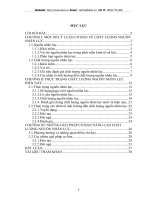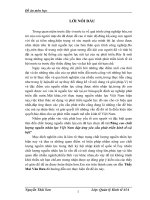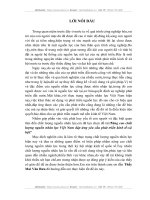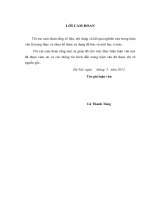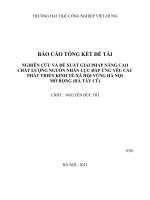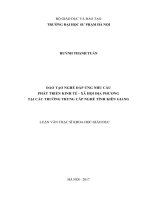Quản lý đào tạo nguồn nhân lực trình độ cao đẳng đáp ứng nhu cầu phát triển kinh tế xã hội thành phố đà nẵng tt tiếng anh
Bạn đang xem bản rút gọn của tài liệu. Xem và tải ngay bản đầy đủ của tài liệu tại đây (354.24 KB, 26 trang )
MINISTRY OF EDUCATION AND TRAINING
THE VIETNAM NATIONAL INSTITUTE OF EDUCATIONAL
SCIENCES
NGUYEN VAN HUYNH
MANAGEMENT OF TRAINING ASSOCIATE DEGREE LEVEL
HUMAN RESOURCES TO MEET THE SOCIO–ECONOMIC
DEVELOPMENT NEEDS OF DA NANG CITY
HỢP TÁC XN TÀI THỦY-BỘ
NỘI ĐỊA Ở ĐỒNG BẰNGG CỬU LONG
Major
: Educational Management
Code
: 9 14 0114
DOCTORAL THESIS RESEARCH PROPOSAL ON EDUCATION
HA NOI – 2019
This research is conducted in:
THE VIETNAM NATIONAL INSTITUTE OF EDUCATIONAL
SCIENCES
Supervisors:
Prof. PhD. Nguyen Loc
Assoc. Prof. PhD. Pham Minh Muc
Debation 1: ………………………………
Debation 2: ………………………………
Debation 3: ………………………………
This thesis shall be under defense before the Thesis Examination Board at
the Institute level, The Vietnam National Institute of Educational Sciences,
101 Tran Hung Dao, Ha Noi at……….. , date ....... month ...... 2019
This thesis is available in:
The National Library of Vietnam
The Library of Vietnam National Institute of Educational Sciences
1
INTRODUCTION
1. The urgency of the topic
The human resources quality is the driving force of socio-economic
development. It also plays a significant role in determining the success level
of national industrialization and modernization. The thing is, human
resources quality depends greatly on training and education activities.
Acknowledging their importance, the educational institutions and
Colleges have spent great effort to manage training activities, apply intiative
educational models with the aim to improve training quality, as well as to
meet the demand of the society on education.
Since its formation in the 1970s, ADDIE the training model has focused
on the enhancement of a close cooperation between enterprises and
educational institutions. Each stage of this model is implemented on the
basis of joint participation of both the enterprise and the training institution.
Hence, choosing and utilizing
ADDIE model in the current training
management at colleges is a proper direction to follow.
Being considered the center of education in the Central region and Central
Highlands of Vietnam, Da Nang City ownes 15 universities, 20 colleges and
dozens of vocational training institutions. In recent years, educational
institutions in general and colleges in Da Nang in particular have put many
efforts in completing the training content, training programs, teaching method
and training management method. Initially, certain good results have been
achieved. Though, there remains a number of limitations in educational
administration: training plans are developed mainly on the basis of available
resources of the training institution, not depending much on the society’s
demands; the training focuses much on theoretical knowledge while not
giving enough training on skills, which stands for the reason of the lack of
skills to adapt to the work environment when students graduate and start
working, enterprises have to re-train the students from scratch, …. That fact
has put the educational institutions before the inevitable requirement to
upgrade the educational management in accordance with socio-economic
development needs, to adjust the training programs to the actual state of the
2
labor market for higher training activities effectiveness, which is also a
method for the brand reputation promoting and developing of Colleges.
The aforestated reasons have urged the author to conduct his doctoral
reasearch on the topic: “Management of training associate degree level
human resources to meet the socio–economic development needs of Da Nang
City”
2. Research purposes:
The research aims at developing scientific arguments and propose
solutions on Management of the training of associate degree level human
resources in order to meet the socio–economic development needs of Da
Nang City using ADDIE model.
3. Objectives and subjects of the study
3.1. Study objects:
Training human resource to meet socio-economic development needs.
3.2. Study subjects
The management of human resource training for the socio-economic
development demand at Colleges in Da Nang City.
4. Scientific hypothesis
Currently, the management on training of associate degree qualified
human resource at colleges in Da Nang City remains limited from the input
management, process management to the output management. If the ADDIE
model is applied, it will contribute to training of college level human
resource to meet the socio-economic development demand in Da Nang City.
5. Content and scope of research
5.1. Research contents
Study the theoretical basis of managing the education of human resource
at college level to meet the socio-economic development needs.
Practical research on the management of college qualified human
resource at colleges in Da Nang City to meet the socio-economy
requirements.
Proposing solutions to training human resource at college level to meet
the socio-economic development demand at colleges in Da Nang City. One
of the proposed solutions is pilot to ensure its reliability as well as feasibility.
3
5.2. Scope of study
The thesis study the current status of college level human resources
training management of colleges in Da Nang City in the period of 2012-2016.
As for human resources: the thesis shall only focus on researching
college-level human resources in Da Nang City.
As for the scope of the survey: The author conducts survey on some unit
deploying human resources and some colleges in Da Nang City only.
Solutions mainly applied in colleges.
6. Methodology and research methods
6.1. Research Methodology
The author mainly uses: Systematic approach; Historical - logical
approach; Market approach; Process approach and output target approach.
6.2. Research methods
The author uses research methods as folllows: Method of theoretical
research; Survey method by questionnaire (the author investigated 300
votes); Methods to summarize practical experience; Professional solution;
Support method
7. The place to carry out the research topic
The thesis was conducted at the Vietnam National Institute of Educational
Sciences
8. Basic research points
In order to gain an adequate view and pratical solutions in managing the
associate degree level human resource to meet the socio-economic
development demand, it is necessary that:
Firstly, it is required to take the rules of the market economy into
consideration, conduct supply-demand analysis, analyse the current status of
human resources, emphasize on forecasting training needs… to develop
appropriate education roadmap, training programs, and study majors,
ensuring the efficiency economically and socially. On that ground,
formulating the system of colleges appropriately.
Secondly, there must be strong decentralization so that colleges could
operate independently and bare the responsibility for their education quality
4
before the society by their owns, thereby promote the creativity, dynamism
and innovation in a positive way.
Thirdly, the proposed solutions must be piloted in colleges to test and
ensure the rationality, feasibility and efficiency.
9. State of the Art.
Theoretical contributions:
Systemizing, completing and developing the theory of human resource
education management in general and the human resource at the associate
degree level in particular to meet the local socio-economic development
needs in the context of market economy.
Identify factors affecting the demand for human resource at the associate
degree level for socio-economic development in Da Nang City.
Practical contributions
The thesis evaluates achievements, limitations and causes of limitations in
training and management of training of college-level human resources in Da
Nang City. With that considered, the thesis author proposes a system of
solutions to boost the efficiency, effectiveness of the mangement of associate
degree level human resource education aiming at meeting the socio-economic
development demand of Da Nang City. Especially, one of which has been
piloted at Da Nang College of Economics – Planning to ensure the feasibility
of the solution.
10. The layout of the thesis
In addition to the introduction, conclusion, the list of published studies
and the list of reference; the thesis consists of 3 main chapters:
Chapter 1: Theoretical basis of socio-economic development needs
based human resources education management
Chapter 2: The actual situation of socio-economic development demand
based associate degree level human resource education management in Da
Nang City.
Chapter 3: Management solutions for training human resources at
associate degree level to meet the socio-economic development needs of Da
Nang City.
5
CHAPTER 1
THEORETICAL BASIS OF MANAGEMENT OF TRAINING
HUMAN RESOURCES TO MEET THE SOCIO-ECONOMIC
DEVELOPMENT DEMAND
1.1. Overview of research on managing the human resource education
1.1.1. Studies on the management of human resource training conducted in
foreign countries
There have been many scientific works on human resource management of
researchers around the world. Each of them dealed with the topic from a
different point of view. However, they agreed that it is important to focus on
the one target: educating human resource in order to meet socio-economic
development needs. These studies results are considered valuable theoretical
and pratical bases for studying the management of socio-economic
development demand based human resource education.
1.1.2. Studies on the management of human resource training conducted in
Vietnam
A number of scientists in Vietnam have studied the education,
management of human resource education according to social demands, or
the education of human resource to meet the needs of socio-economic
development; They have mentioned issues sharring the same nature: to
implement education according to the implementation capacity as well as the
output standards.
In short, the published studies have provided a variety of viewpoints,
subjects and objects of study, as well as identified several good models,
solutions to enhance the quality of education and education management to
meet the market demand, such as process approach method. In the current
development trend of the labor market, the quality of human resouces,
especially those at associate degree level plays an increasing significant role,
particularly in developing the competitiveness for enterprises and for the
employees themselves. The management of human resources needs to be
carefully studied in each market segment divided according to the level of
labor market sector. From a local perspective, namely Da Nang City, it is
expressly required to in-depth study the management on training associate
degree level human resources at the education institutions so as to fully meet
6
the socio-economic development needs of such a key city in the Central of
Vietnam.
1.2. Some basic concepts
1.2.1. Human resources
According to the author, in view of a country or a locality, human
resource is the total number of labors in the labor force of that country of
locality who are capabled of working, already or ready to work in sectors of
the social economy. Assessment of human resources needs to be analyzed in
all three aspects: quantity, quality and human resource structure.
1.2.2. Management and educational management
1.2.2.1. Management
The author is of the opinion that management is the process in which the
management subject uses certain methods and tools to affect to the
management object in a specific environment in order to achieve the desire
and expected goals. Management has 4 functions: Planning, implementing
organization, direction and inspection-evaluation.
1.2.2.2. Educational management (Training management)
Educational management is the impacts that the management subject
leaves on the management object in the training process through functions of
management and with appropriate management tools and methods to achieve
the educational objectives so that learners can acquire competencies
according to defined standards.
1.2.3 Management of human resource training
1.2.3.1 Human resource management
The management of human resources could be considered under different
views: from the perspective of the locality, and from that of the enterprise.
Local human resources management aims at promote the efficient use of
human resources, ensuring the balance structure of qualifications, occupations
and necessary skills for economic development under the expected socioeconomic development strategy. From the view of enterprise, human resources
management includes stages of recruitment, deployment, and training.
1.2.3.2 Human resource education
Human resources education is understood as the process of aquiring
7
professional skills and forming attitude, beliefs, moral behaviors for labors so
that they are qualified for certain types of jobs.
Currently, several of scholars are interested in the ADDIE model, which
brings about many benefits and works well on training the human resources
according to market needs.
1.2.3.3 Educational management of human resources
From the view of educational institutions, educational management of
human resources is the administration of educational planning and
performing,… to train specific labors with proper skills and knowledge to
meet the requirements of the market and of the enterprisesk, as well as to
conform with the general strategy of the locality and the country.
1.2.4. Human resources at the associate degree level (college-level)
According to the author, the education of human resources at the
associate degree level means the training of labors with level 4 occupational
skills, also known as high level technician. So, college-level training
institutions should differentiate the learners so as to make it easier for giving
them appropritate level of education.
1.3. Models of educational management applied in educational
institutions
In addition to ADDIE, in fact, there are a wide range of administration
models for educational quality such as: CDIO Approach (Conceive Forming Ideas, Design - Implementing - Deploying and Operate); Training
management according to the PDCA cycle (Plan - Planning, Do - Perform,
Check - Check, Action - Action); Leonard Nadle model; Process
management.
1.4. Training human resources at the associate degree level
1.4.1. Educational objectives
For the training of college-level human resources, the educational
objective is associated with developing a workforce with sufficient
occupational knowledge and pratical skills, appropriate attitude and labor
discipline, good behavior, knowledgeable, health, aesthetics for meeting the
economy’s development requirements.
1.4.2. Contents of the educational program
8
Contents
of
the
educational
program
should
be
fundemental,
comprehensive, practical, updated, scientific and systematic knowledge
specialized for each study major, as well as classified in subjecs/modules for
the educators to teach and the learners to acquire in the aim of accomplishing
educational objectives.
Educational program at the associate degree level must ensure that 30%50% of its content is on theoretical knowledge; the rest 50%-70% is for
practice.
1.4.3 Methods and forms of training organization
Methods and forms of educational organization contributes greatly and
decisively to the education quality. However, methods and forms of
educational orperation depend on various factors like object o study,
educational objectives, lecturer’s pedagogical capacity, facilities, etc.
1.4.4. Training staff
The educating staff include lectures and employees working on
management, educational services, teaching.
1.4.5. Conditions on facilities, teaching tools and equipement
The facilities and equipment used in teaching-learning must be
appropriate and advanced in technology, ensuring that learners find the
technology they learned with when in the college is not out-of-date and still
helpful even when they have graduated.
1.4.6. Quality and efficiency of education in the market mechanism
The criteria for evaluating education quality is to achieve the teaching
objectives, mission, to get the highest results in teaching and learning with
the least necessary expenses, time, effort, finance of lecturers, learners, the
people and the Government.
1.4.7 The role of training college-level human resource in socio-economic
development
Associate education is a vital, decisive element in building human
resources and developing the country.
1.5. Manage training of human resources at college level to meet the
needs of local socio-economic development
9
1.5.1. Objectives of managing the education of human resource at collegelevel at educational istitutions to meet local socio-economic development
needs.
The focal point of the educational management process is: improving the
quality and efficiency of educational activities, supplying the market a
skillful, well-trained in specific occupations, meeting the socio-economic
development demand.
1.5.2. Contents of human resource educational management at educational
institutions to meet local socio-economic development needs.
From the perspective of educational institutions, contents of human
resources educational management include:
1.5.2.1 Management of enrollment
1.5.2.2 Management of developing training program
1.5.2.3 Management and development of the teaching staff
1.5.2.4 Management of the facilities and teaching equipment
1.5.2.5 Management of teaching planning
1.5.2.6 Management of graduation degrees, diplomas issuance
1.5.3. Educational management in colleges under ADDIE model
ADDIE model focuses on strengthening the close cooperation between
enterprises and educational institutions. Each stage of this model involves
both the enterprise and the educational institution. The implementation of all
stages is carried out on the basis of collaboration and participation of
enterprises and educational institutions jointly.
Groups of management content: input management, process management,
output management and affects of the context to educational management.
These groups are divided into 5 stages, in particular: Stage 1: Organization
and analysis of education demand; Stage 2: Design management and input
management of educational institutions; Stage 3: Direction, organization of
implementing education activities in education institutions; Stage 4:
Direction, organization of implementing human resource educational
management; Stage 5: Evaluating the human resource education in output
management and make response for improvement.
1.6 Factors affecting college level human resources educational
management for local socio-economic development needs.
10
The fundemental factors affecting associate degree level human resources
educational management in order to meet the local socio-economic
development demand are as follows: governmental management on the
education
of
associate
degree
level
human
resource;
Technology
advancement; Capacity of leaders and management staff of the educational
institutions; Finance.
CHAPTER 2
THE ACTUAL SITUATION OF ASSOCIATE DEGREE LEVEL
HUMAN RESOURCE EDUCATIONAL MANAGEMENT FOR
SOCIO-ECONOMIC DEVELOPMENT NEEDS IN DA NANG CITY
2.1. An overview of geographical, socio-economic conditions of Da Nang
City
2.1.1. Geographical conditions: Da Nang is blessed with more favorable
geographical conditions to develop than those of other localities in the
Central of Vietnam.
2.1.2. Socio-economic conditions
Da Nang is recognized as one of the economic centers having rapid,
continuous and stable growth rates.
GRDP per capita (at the current price) also increases enormously over
years. In 2012, GRDP per capita of Da Nang is 48.39 million Vietnamese
dong, In 2016, it has increased by 64.20 million Vietnamese dong.
In 2016, Da Nang has fundamentally achieved most of the set socioeconomic targets.
2.1.3. The actual status of human resources in Da Nang City
* Quantity:
The human resource scale in the territory of Da Nang City has increased
from 531,375 people in 2012 to 556,124 people in 2016. The average
increase rate in 2012-2016 is 1.03%/year.
* Human resource structure by gender:
The indicators on labor show that, the increase rate of female labors is
higher than that of male labors. The participation of female labor in the labor
force has rised from 49.32% in 2012 to 51.02% in 2016.
* Human source structure by age group
11
Most of the city’s labor is at young age, of which labors who are under 35
years old account for 52.13%; distributed mainly in urban area with 87.62%,
and 12.38% in rural area.
* Supplies of human resource
The labor force in the city in the period 2012-2016 averaged 541,140
employees/year, an average increase of 1.03%/year. This labor force is
supplemented by about 50% of the population entering the working age of
the city and 50% from the annual population increase.
* Quality of human resources
General education, as well as professional – technical education level of
the City’s labor force are continuously raised.
2.1.4 Actual situation of human resource demand in Da Nang City
In recent years, the demand for human resource of the City is increased.
Of 556,124 people of working age, there are 532,360 people is working for a
job, accounting for 95.7% (2016).The labor force with highest rate of
employment is human resources with associate degree level (91.9%, 2016),
labors
with
intermediate
(technician/technical worker,
diploma
degree
ranked
the
second
90.4%) while only 63.9% of people with
university degrees was employed.
It is expected that, by 2025, Da Nang City will need 25,000 more labors.
This is not only job opportunities for qualified labors but also a chance for
educational institution to expand their scales of training.
2.2. Actual state of the education of associate degree level human
resource in order to meet socio-economic development demand of Da
Nang City
2.2.1. Studying the actual state by conducting surveys
2.2.1.1. Purpose of the survey
Evaluating strengths and witnesses of the human resources educational
management at colleges in Da Nang; thereby generating objective, scientific,
accurate conclusions serving as the basis of solutions.
2.2.1.2. Contents of the survey
12
To collect data on the actual situation of associate degree level human
resource and on the extent of satisfying the demand for human resources of
Da Nang City.
2.2.1.3. Method and tools utilized in surveying
Survey toolkit: From February 2017 to December 2017, the author has
design the questionnaires, conducting the survey on the actual situation of
human resources education in Da Nang City.
Method used: utilizing a combination of various investigating, surveying
methods.
2.2.1.4. Subjects of surveying
The survey was carried out at 10 colleges (35 management staff, 125
lecturers, 150 students); 55 management staff and economic officials; 35
alumni at associate degree level in 40 enterprises in Da Nang City which is
deploying human resources at associate degree level.
2.2.1.5. Results of the survey
Table 2.10 to 2.24 extracted from the results in appendix 6 (In the thesis)
2.2.2. The actual situation of training colleg-level human resource in Da
Nang City
2.2.2.1 The network of associate degree level educational institutions:
By 2016, Da Nang shall have 20 colleges, which means there will be
more opportunities, more educational institutions and a wider range of study
environments for learners.
2.2.2.2 Annual scope of enrollment and graduation
The associate degree level education scope of colleges has a tendency to
drop year by year, even in state colleges. The number of students applying
for associate programs in 2016 was 7,271 students, decreasing nearly 50%
compared to that of 2012, 13,097 students.
2.2.2.3 Structure of study majors
Currently, colleges in Da Nang City provide training programs for upto
159 fields of study. These colleges are multi-discipline but basically focusing
on certain industries like accounting, business administration, and
hospitality-tourism.
2.2.2.4 Ratio of employment after graduation
13
In 2013-2016, the ratio of getting a job in the trained industry of
graduates was reasonably high and increased each year, from 73.35% in 2013
to 79.6% in 2016. However, there remained a part of students employed for
jobs which were unrelated to their study majors (20.4%, 2016)
2.2.2.5 Conditions for ensuring the development of education:
Most of educational institutions in Da Nang City are equipped with quite
good facility for educational work. The system of governmental agencies in
Da Nang territory and policies create favorable conditions for colleges to
work efficiently.
2.2.2.6 Lecturers and management staff
The management staff includes 578 people, of which there are 70 doctors,
237 masters and 161 bachelors/ MD.
There are 1517 lecturers, 65 of which are at doctoral level, 925 at master
level and 441 at bachelor degree level. This is concrete evidence that the
lectureres and staff are caliberated and also, they are qualified for the higher
and higher standards for working in the field of education.
2.2.2.7 Training program
Basically all the training programs of the schools comply with the framework
program issued by the Ministry of Education and Training.
2.2.2.8 Financial resources
The city always pay much attention to the investment in the development
of education, training and vocational training. The budget proportion spent
on this sector is increasing compared to the total budget expenditure, in 2012
accounted for 6.71%, in 2013 was 7.86% and in 2016 was 12.2%. Therefore,
the facilities and practice areas of the schools are invested and upgraded,
basically meeting the practical needs of students.
2.2.2.9 Results of human resource education
So far, colleges in Da Nang City have contributed quite an abundant
source of labor force for not only Da Nang City but the Central region –
Central Highlands of Vietnam as well. The quality of education is enhanced,
focusing on training soft skills in parallel with professional skills.
2.2.4. Actual Situation of human resource use in Da Nang City
The City’s labor force accounts for a high proportion in the general
14
human source. Though, the unemployment rate remains high (6.68% in 2010;
4.34% in 2015). The labor structure of the city is shifting in line with the
economic development structure.
According to a study on the human resource policy of Da Nang, there are
41.7% participants stated that Da Nang has not had good policies on human
resource. The workforce is distributed unevenly by region and region.
2.3. Actual status of educational management in colleges in Da Nang City
2.3.1 Management of enrollment
The enrollment and school admission are self-manage by the colleges.
Enterprises hardly participate in this process.
2.3.2 Management of developing educational program
Studies show that, many education programs remain behind the socioeconomic development need and the practical manufacture situation, for they
are implemented on the basis of available resources of the colleges.
2.3.3 Management of teaching staff
Currently, most colleges encounter the phenomenon of local redundancy
and lack of labors. Colleges have so many lecturers to teach theories while
lacking lecturers to teach new professions, as well as teachers who are welltrained for technical subjects or high professional skill level for teaching
practical subjects.
2.3.4 Management of teaching facilities and equipment
As been shown in study results, colleges are still lack of essential
equipment, machinery. The operation of teaching facilities and equipment
system does not meet the requirements. It is because each practice lesson in
workshops/practice room may be used for twice or three times of the
standard number of students (18-22 students).
2.3.5 Management of teaching plan
2.3.5.1 Management of teaching activities
The management of lecturers’ teaching activities is still formal and
performed in an administrative way. Lessons given by lecturers mainly
follow a format standard curriculum, based on form 3 or form 4.
2.3.5.2 Management of assessment and graduation examination
Up to now, no colleges in Da Nang City has managed to develop a
15
scheme of procedures, instructions on monitoring, evaluating and
systemizing. Therefore, the assessment has not been systemized nor
synchronized.
2.3.6 Management of issuing graduation certificate and diploma
All colleges in Da Nang City abide by the management of issuing
graduation diploma and certificate in compliance with regulations on
certifications and diploma of the national education system.
2.4 Factors affecting the management of human resources at colleges in
Da Nang City.
2.4.1 The Government’s management on the education of associate degree
level human resource
All documents and regulations issued in the past has provided
development opportunities for the education of associate degree level human
resource in order to supply the market with a source of labor with sufficient
occupational skills, workmanship, serving the growth of country and
accomplishing education objectives.
2.4.2 Local socio-economic development needs
In the past few years, the investment in Da Nang City has emerged
rapidly, resulting in the increasing demand for human resources, especially
those at associate degree level.
2.4.3 The technology advancement
The past few years witnessed the strong development of science and
technology. With that give, colleges have gradually applied modern
technology in teaching theory. They have invested strongly in workshops to
facilitate efficient teaching and learning activities.
2.4.4 Finance
Da Nang now has 9 State colleges, 6 of which are under the management
of governmenting Ministries and gain interest and huge investment from
these Ministries. Private colleges have relatively large capital and high tuition
fees so basically, they are financially stable.
2.4.5 Capacity of leaders and management staff of colleges
Rectors of colleges in Da Nang City have at least the Master
qualifications. According to the survey, those leaders, managers have both
16
leadership and vision for the development of the colleges.
2.5. Overall assessment on the human resource training management
actual state at colleges in Da Nang City.
2.5.1 Achievements
The colleges have diversified training forms to meet the demand of socioeconomic development. Material facilities and teaching facilities are invested
with modern and advanced technology. The training program is also
gradually improved and closer to reality. Leaders, managers and teachers at
colleges are young, creative and fast-approaching with new training methods.
2.5.2 Limitations
The training quality of college remained low, a large number of students
who have completed their studies cannot find jobs. Despite the improvement
and upgradation, the facilities and teaching facilities of colleges have not
kept pace with the trend of scientific and technological development.
Teachers still fail to meet the renovation needs of the educational program.
2.5.3 Causes of the above limitations
The management of training human resources at associate degree level is
still limited. This results from many causes including local authorities,
educational institutions, enterprises and even the learners.
CHAPTER 3
MANAGEMENT SOLUTIONS FOR TRAINING HUMAN
RESOURCES AT ASSOCIATE DEGREE LEVEL TO MEET THE
SOCIO-ECONOMIC DEVELOPMENT NEEDS OF DA NANG
CITY.
3.1. Orientation of socio-economic development and forecast of human
resource needs
3.1.1. Orientation of the socio-economic development of Da Nang City
The municipal economic structure needs to be transformed towards
services - industry, construction - agriculture.
3.1.2. Forecast of the human resources demand in Da Nang City
3.1.2.2. Forecast of human resources demand in Da Nang City by 2020
17
It is forecasted that the Da Nang City's labor demand will increase and the
demand for labors trained in the service industry will continue to rise high.
(Specific data in table 3.1; 3.2; 3.3 in the thesis)
3.2. Solutions to educational management of associate degree level
human resource
3.2.1. Improve the management effectiveness of training needs analysis
activities
- Purpose of solution: In order to overcome existing limitations in
information collection and context analysis at colleges in Da Nang to create
an important database serving for design and development, deployment and
evaluation of human resource training activities.
- Content of solution: Analyze, forecast and formulate a database system
on the demand for training college-level human resources to meet the needs
of socio-economic development in a timely manner; thereby develop training
plans for vocational training getting ahead of the trend of careers, catch up
with the development trend and getting closer to the local current situation.
- Method of implementation: Fully implement 4 steps: Planning;
Organizing implementation, Directing implementation and Examining,
evaluating.
- Conditions for implementing the solution: The colleges financial sources
must be strong enough to equip activities of collection, process information,
modern information technology equipment and machinery.
3.2.2. Complete the training program design activities and manage the
quality assurance conditions
3.2.2.1. Manage the design of associate training programs
- Purpose of solution: In order to formulate a suitable college-level
curriculum, meeting the market requirements.
- Content of solution: Design and develop a suitable training programs to
businesses needs, adapt to each learner, conform with the capacity of teachers
and the college's facilities.
- Method of implementation: Educational management under the socioeconomic development needs should follow the 7-steps cycle: Establish a
Steering Committee, a standing department to collect information about the
18
labor market, careers and develop a training program; Planning the training
program development on the basis of obtained information, determine the
required output standards of the study majors; Direct, guide and organize the
training curriculum development; Issue the output standards and training
programs; Organize training according to the training program; Inspection
and evaluation of training curriculum; Make adjustment and supplement
every year.
- Conditions for implementing: Establish the Pedagogical and Scientific
council to appraise output standards and training curriculum with the
participation of enterprises' experts in each suitable study major.
3.2.2.2 Manage the quality assurance conditions to meet the requirements
of college level training
- Purpose of solution: Overcome limitations in organization and increase
management efficiency of the quality assurance conditions to meet the needs
of socio-economic development.
- Content of solution: Organize, train and improve the qualifications of
teachers; Effectively manage facilities and equipment.
- Method of implementation: Manage and develop teachers in order to
meet vocational training requirements; Improve the system of teaching and
learning equipment to meet vocational training requirements
- Conditions for implementing the solution: Colleges must formulate a
scientific process in managing the quality assurance conditions and strict
adherence to this process.
3.2.3. Strengthen direction and organization of the training activity
development
3.2.3.1. Direct, organize and manage, allocate training programs in order to
meet training activities
- Purpose of solution: Provide learners with appropriate training
programs, meet the market demands
- Content of solution: Manage, select, allocate the training programs to
suit each learner, fit the businesses needs, match the capacity of the college's
teachers and the college's facilities.
- Method of implementation: Formulate a training management program
under 9 steps: (1) Determine needs; (2) Formulate profiles of graduates'
19
capacity; (3) Analyze initial situation; (4) Divide and decide the structure of
learning content; (5) Choose educational methods; (6) Formulate organization
ways of the teaching and learning process; (7) Develop teaching and learning
materials; (8) Formulate regulations on assessment and examination; (9)
Formulate procedures for implementing education and training activities.
- Conditions for implementing: The colleges need to have an effective
information system for human resource needs of each industry and with the
participation of employers in developing programs and determining the
necessary implementation capabilities.
3.2.3.2. Strengthen management activities to develop the connection between
colleges and enterprises
- Purpose of solution: Students have access to enterprises while they still
sit in the school chair, so that students can get practical knowledge of the
fields of study they are being trained.
- Content of solution: Agree on the linking policy between colleges and
enterprises, develop plans for annual training linkages between colleges and
enterprises.
- Method of implementation: Enhance cooperation with enterprises,
signing minutes and agreements. Directly bring students to study at
enterprises, invite skilled workers and employees from enterprises to be the
guide for learners in the training process. Examine and evaluate the training
affiliate activities with enterprises and learn from experience to improve
operational efficiency.
- Conditions for implementing the solution: The colleges must have
good relationships with enterprises and must have experts from these
enterprises to participate in developing training curriculums.
3.2.4. Improve the management effectiveness of the implementation of
human resource training process at colleges
3.2.4.1. The consultancy in career orientation activity and vocational
enrollments according to the demands of socio-economic development
- Purpose of the solution: Direct enrollment activites to ensure the input
quantity and quality in accordance with the capacity of learners, the capacity
of colleges in the city territory. Limit the phenomenon of local redundancy
20
and lack of labors in the future.
- Content of the solution: The college should develop an annual
enrollment plan and both detailed enrollment plan for each study major with
appropriate timing and placement in order to obtain the best results.
- Method of implementation: Develop an overall plan of enrollment
activities throughout the year as a basis for making detailed plans for each work
group, from time to time, ... Invest in material facilities, technology equipment
and employees.
3.2.4.2. Manage the teaching process
- Purpose of solution: Create a mechanism to promote the labor training
process at colleges that approaching closer to market requirements.
- Content of solution: Organize the teaching process according to subjects
or modules of the training curriculum..
- Method of implementation: Manage all stages in the training process.
- Conditions for implementing the solution: The enterprise must
participate in the assessment and evaluation process. There must be a
procedure of managing and developing scientifics program in line with with
the development of era.
3.2.5. Improve the management effectiveness of output assessment
activities and operations of issuing diplomas and degrees at colleges in Da
Nang
3.2.5.1. Manage the assessment of output results according to professional
competence standards
- Purpose of solution: Agree on method of organization and
implementation of process of examining and monitoring the output result
evaluation.
- Content of solution: The colleges formulate and issue output standards
specialized for each study major in line with business requirements. Organize
and assesses students' ability to accumulate on all three aspects of
knowledge, skills and attitudes.
- Method of implementation: Implement all stages in the assessment
process based on the target basis of professional capacity and market
requirements on training labors.
21
3.2.5.2. Complete assessment activities and output information management
- Purpose of solution: Improve the quality of output management at
colleges in Da Nang City in order to serve the colleges to assess and adjust
training activities, further meet market requirements.
- Content of solution: Develop a plan to coordinate with enterprises in
formulating an output information system. Setting up the output system
through the application of modern management tools and equipment.
- Method of implementation: Each college needs to establish a specialized
department to collect and manage the output information. Enhancing the
cooperation between colleges and enterprises.
- Conditions for implementing the solution: Information collection and
processing department must operates effectively. In addition, the city also
must provide a complete and comprehensive information system about
market demand for associate degree level human resources so that
enterprises can uses it as a basis for assessment.
3.3. Survey and collect consults of experts on some solutions for
educational management at colleges in Da Nang City
- Purpose of survey: In order to collect consults of experts on the urgency
and feasibility of solutions.
- Content of survey: The urgency and feasibility of solutions.
- Method of survey: Use survey forms (questionnaires) to collect consults
of experts. The opinions and criteria shall be scored on a scale which has
formulated the urgency and feasibility of each proposed solution. The scale is
from 1 to 5. The assessment result is the average score of the evaluation
opinions for each solution.
- Result of survey:A survey conducted on 100 experts including: 10 state
management officers on human resource training; 60 managers and teachers
of training institutions in Da Nang; 25 managers of enterprises and 5 staffs of
the Da Nang Institute for Socio-Economic Development Studies.
All participating experts agreed that all 5 solutions were urgent (rated
over 64%). The number of experts evaluating less urgent solutions accounts
for less than 10%. There is no solution that is not urgent.
The highest scored solution is solution No. 5 with an average score of
4.08 with 31% vote to be really urgent and 51% ranked as urgent.
The solution underestimated by experts is solution No. 1 and 2 with an
22
average score of 3.69 points.
The three solutions that are evaluated by more than 75% of experts are
highly feasible and very high, which are solutions No. 2; 4 and solution 3.
3.4. Testing the solutions
Due to time constraints and the specificity of each major, courses and
operations of enterprises, the author only chose one solution to test: (i)
Strengthen the direction work and organize the development of educational
activities with 2 contents: (1) Direct and organize the development of training
programs to meet the needs of socio-economic development; (2) Organize
training linkages between the colleges and the enterprises in tourist hotel
services. The solution was tested at Da Nang College of Economics and
Planning. Through the results obtained from tables 3.8 and 3.9 (in the thesis)
show that if the above two solutions have been implemented that will bring
very high efficiency for the involved parties (the average score of opinions
almost reaches maximum).
CONCLUSIONS AND RECOMMENDATIONS
Conclusions
In past years, under the pressure of exist-development and competition,
educational management activities have had qualitative changes. Therefore,
the selection of an appropriate training management model is very important.
The ADDIE model used and applied in training management is an effective
solution for educational institutions to make reference.
Generally, the actual training management at educational institutions and
at colleges in Da Nang city in particular still faces many limitations. The
author has proposed 5 solutions to overcome weaknesses, improve training
quality and management efficiency. The opinions collected from experts
indicate that all solutions are suitable to the reality, necessary, urgent and
feasible. Although there are some concerns about feasibility of the proposed
solutions, most of the opinions suggest that it is necessary to innovate from
administrative-regular
management
method
into
quality-oriented
management.
Recommendations
* For the Ministry
Focus on developing training and human resource development plans
based on the basis of forecasted market demand and socio-economic changes
23
in the future; Strengthen educational propaganda on careers, needs and social
responsibilities of enterprises in training and using human resources;
Modifying regulations and guidelines related to formulation and publicity of
output standards and development of training programs; Institutionalize job
resolution support for learners after training with specific policies and
mechanisms; Continue to invest properly in colleges to ensure the minimum
conditions when organizing training and educational management.
* For the Government of Da Nang City
Establish a labor market information center, forecast the labor market of
the city and surrounding areas to provide necessary information to colleges;
Create favorable conditions on policy and land mechanism to develop the
scale of cooperation opportunities with training partners as well as domestic
and foreign enterprises; Enterprises have the social responsibility of creating
a mechanism to encourage enterprises to actively participate in vocational
training activities and stipulating the participation and contribution in
vocational training.
* For training institutions
Pay more attention to the training management activities under market
demands. Review the overall system of regulatory documents and profiles to
adjust, unify and perfect; Increase investment and development material
foundations, nurish high-quality teaching staff and officials, employees
serving in training activities. Focus on cooperation with businesses in human
resource training.
